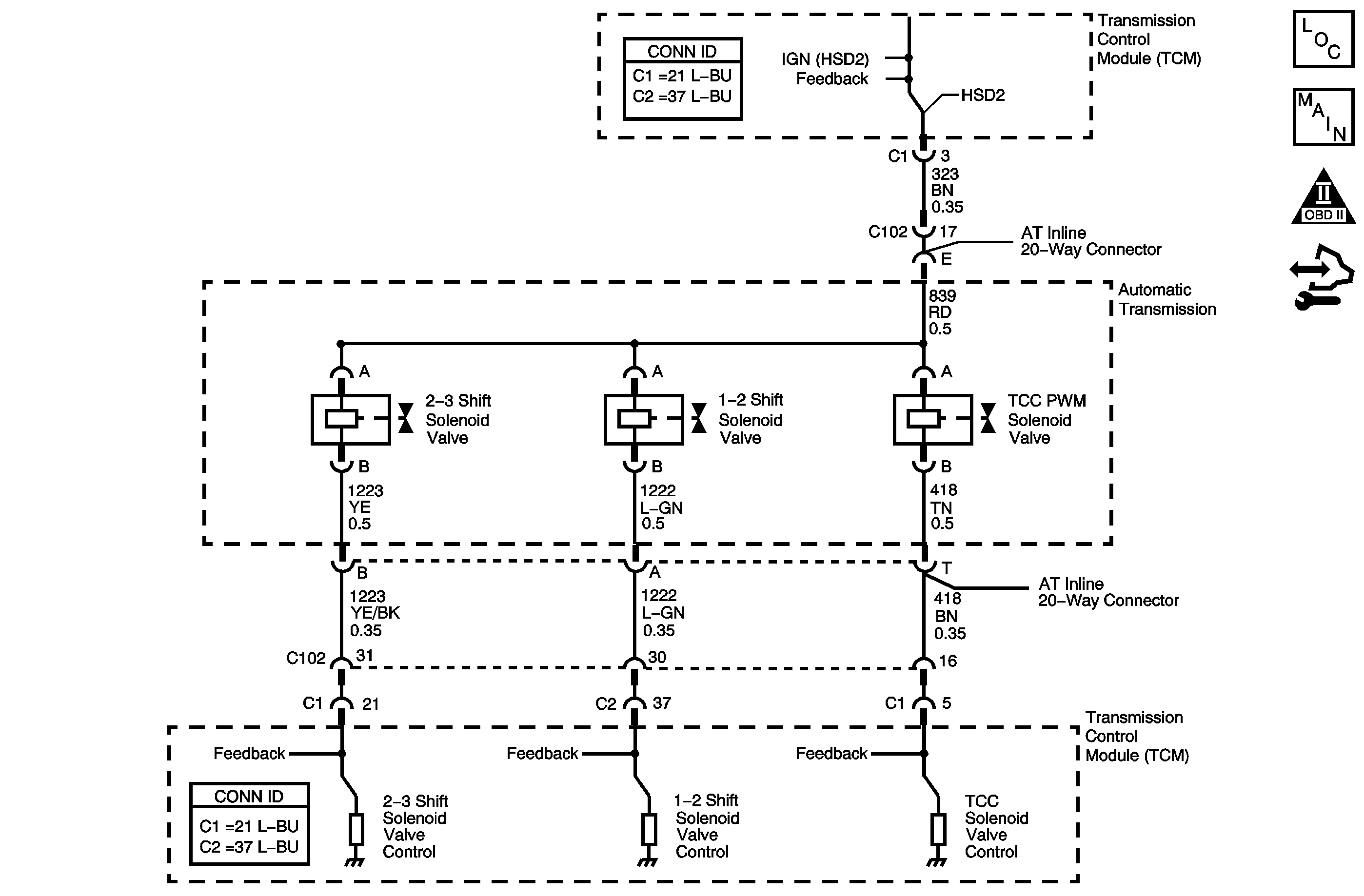DTC P1833 Non-Hybrid

Circuit Description
The transmission control module (TCM) provides voltage to the pressure control solenoid, the shift solenoids, and the torque converter clutch pulse width modulated (TCC PWM) solenoid through 2 separate solid-state devices called high side drivers (HSD) - HSD1 and HSD2. HSD1 provides electrical power to the pressure control solenoid. HSD2 provides power to the shift solenoids and the TCC PWM solenoid. A normal function of the TCM is to run tests on each driver to ensure that it is functioning properly.
When the TCM detects an open or a short to ground on HSD2, DTC P1833 sets. DTC P1833 is a type A DTC.
DTC Descriptor
This diagnostic procedure supports the following DTC:
DTC P1833 Torque Converter Clutch (TCC)/Shift Solenoid (SS) Control Circuit Low Voltage
Conditions for Running the DTC
| • | The engine is running for 5 seconds and not in fuel cut-off. |
| • | HSD2 is commanded ON. |
Conditions for Setting the DTC
The TCM detects and open or a short to ground on the HSD2 circuit when the HSD2 is commanded ON for 4.4 seconds.
Action Taken When the DTC Sets
| • | The TCM requests the engine control module (ECM) to illuminate the malfunction indicator lamp (MIL). |
| • | The TCM commands an immediate landing to 2nd gear. |
| • | The TCM commands maximum line pressure. |
| • | The TCM forces the TCC OFF. |
| • | The TCM inhibits TCC engagement. |
| • | The TCM commands HSD2 off. |
| • | The TCM freezes transmission adaptive function. |
| • | The ECM records the operating conditions when the Conditions for Setting the DTC are met. The ECM stores this information as Freeze Frame and Failure Records. |
| • | The TCM records the operating conditions when the Conditions for Setting the DTC are met. The TCM stores this information as Failure Records. |
| • | The TCM stores DTC P1833 in TCM history. |
Conditions for Clearing the MIL/DTC
| • | The ECM turns OFF the MIL after the third consecutive drive trip in which the TCM does not send a MIL illumination request. |
| • | A scan tool can clear the MIL/DTC. |
| • | The TCM clears the DTC from TCM history if the vehicle completes 40 warm-up cycles without an emission related diagnostic fault occurring. |
| • | The TCM cancels the default actions when the ignition is OFF long enough in order to power down the TCM. |
Step | Action | Yes | No | ||||
|---|---|---|---|---|---|---|---|
1 | Did you perform the Diagnostic System Check - Vehicle? | Go to Step 2 | |||||
2 |
Important:
Did DTC P1833 reset? | Go to Step 3 | Go to Testing for Intermittent Conditions and Poor Connections | ||||
3 |
Did DTC P1833 reset? | Go to Step 4 | Go to Step 5 | ||||
4 |
Did you find and correct the condition? | Go to Step 9 | Go to Step 7 | ||||
5 | Test the solenoid supply voltage circuit between the AT inline 20-way connector and each individual solenoid for a short to ground. Refer to Testing for Short to Ground. Did you find a condition? | Go to Step 8 | Go to Step 6 | ||||
6 | Replace the shorted solenoid. Refer to 1-2 Shift Solenoid Valve Replacement , 2-3 Shift Solenoid Valve Replacement , or Torque Converter Clutch Pulse Width Modulation Solenoid Replacement as applicable. Is the action complete? | Go to Step 9 | -- | ||||
7 | Replace the TCM. Refer to Control Module References for replacement, setup, and programming. Is the action complete? | Go to Step 9 | -- | ||||
8 | Replace the internal transmission electrical harness. Refer to Wiring Harness Replacement. Is the action complete? | Go to Step 9 | -- | ||||
9 | Perform the following procedure in order to verify the repair:
Has the test run and passed? | Go to Step 10 | Go to Step 2 | ||||
10 | With the scan tool, observe the stored information, capture info and DTC info. Does the scan tool display any DTCs that you have not diagnosed? | System OK |
